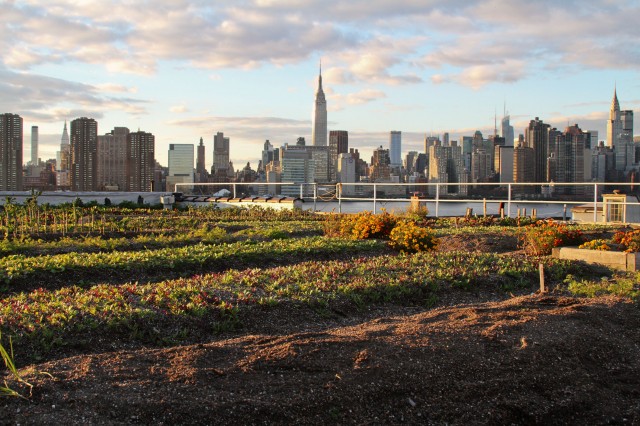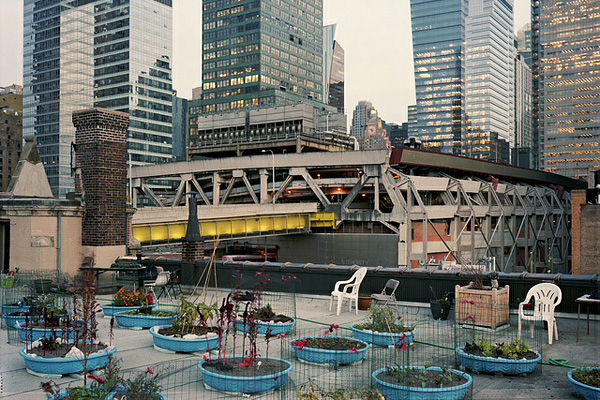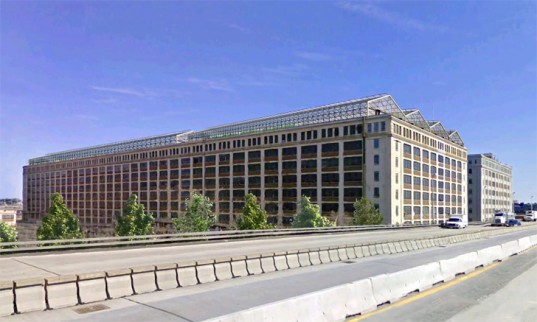When Jane Garmey introduced urban farming pioneer Annie Novak before her lecture at the School of Interior Design last month, she proposed that the urban farm movement encompasses macro–not micro–level farming. The idea is simple and far from new: bring food closer to the core of its consumers, and with it, a better understanding of just how important our food systems are. If we can utilize otherwise wasted rooftop space in the process, all the better. It is small in scale, but symbolizes a widespread, new-found consciousness of sustainable urbanism.
A new generation of city-hip green thumbs have taken root in cities across America, their metro-farming initiatives thriving off urbanites’ hunger for fresh and local produce and willingness to commit–at least with their lunches–to a more responsible city-life.
In the New York urban farming sphere, attention is now focused on the city’s expansive roofscapes. As land trust and publicly owned land is limited–already housing a substantial five hundred community farms and gardens–and empty lots are at a premium, the rooftop is fertile ground.
Novak’s Williamsburg-based acreage, the Eagle Street Rooftop Farm, raises a variety of leaf vegetables, cucumbers, carrots, radishes, and eggplants, and is currently growing hot peppers for production of their new hot-sauce line, aptly dubbed ‘Awesome Sauce’. The farm operates an on-site market, and delivers, usually by bike, produce to area restaurants.
Her farm works much like a ground level farm does, only confined to the environment and limits of a Brooklyn warehouse roof. Green roofing firm Goode Green and building owner and alternative roofing and stage production specialists Broadway Stages helped unload truckloads of an ultra-light but nutrient rich soil substitute. Spread atop a complicated layer of drainage and support material, the post-production mushroom product terraformed the formerly unused space into plowable, fertile rows.
Not all roofs can support a farm, unfortunately. It is unknown how many buildings suitable for holding the increased weight there are currently, but some farmers are beginning to say finding a suitable roof top is becoming a challenge. An effort to quantify available space has yet to surface.
In proper ratios, Novak employs rabbits to fertilize her crops. She says the rabbits, whose fertilizing potential is unrivaled at that size, are perfect for the rooftop environment and provide an attraction for farm tourists. She also keeps chickens and bees. One of the city’s, or even the country’s biggest agricultural quandaries is what to do with the severe lack of pollinators.
“Because there aren’t a lot of green spaces here, we don’t get a lot of pollinators. That’s a bigger issue than most people think” says Novak, who began keeping bees illegally under the Giuliani administration. The bees, which are now legal inhabitants, have the double benefit of providing honey, which the farm sells as well.
Unlike some sci-fi writers and urban visionaries’ claims made 60 years ago, urban farming is not replacing the sprawling fields of the Midwest and Imperial Valley in California. No matter how many ambitious people throw soil on their roofs, the city’s size remains its biggest challenge: Novak and the city’s hundreds of other urban farms and community gardens are not trying to feed the entire metropolis. Instead, Novak just wants to “raise as many green thumbs as vegetables.” If these farms can at least help people understand where their food comes from, that’s a novel first step.
Additionally, many of the farms see themselves as community builders, bringing together friends and neighbors through volunteer opportunities and events for children. Injecting some fresher food into the city is an obvious benefit, but to many, the farms remain more symbolic of New York’s heightened environmental conscious than of serious, sustained benefit to the city.
Not everyone sees it this way, though. New York has never settled for second place, and the city already has the largest rooftop farms in the world. Several companies are vying for usable rooftops that could add much needed jobs as well as fresh produce.
A city-owned food distribution hub in Hunt’s Point, Bronx is seeking to develop its 200,000-square-foot rooftop. Although some remain concerned over the buildings need to bolster its support structures, a farm here would likely be the most productive rooftop farm in the world, with the added value of being only an elevator shaft away from accessing city-wide food distribution networks.
Companies like Brightfarms and Gotham Greens are creating intensive hydroponic landscapes on rooftops and selling direct to supermarkets. This arrangement both decreases the cost to consumers and raises profits for the farmer. Taking out the middleman is a trend right now in north eastern farming, with many farmers trucking produce to markets and restaurants themselves, sometimes traveling over 100 miles for a single farmers market.
Brightfarms, which operates the world’s biggest rooftop farm, seeks shelf space contracts with supermarkets in the city. In the long run, the company sees itself constructing greenhouses on the roofs of hundreds of grocery stores around the country, practically zeroing the food miles, or how far your food has traveled from farm to shelf.
These are farms where food and tech are really colliding. Gotham Greens grows acres of lettuce with no soil in site. Hydroponics drip feed nutrient enriched water straight to the plants roots held uniformly in a holster. At Brightfarms’ greenhouses, they employ an integrated monitoring system which can signal a remote farmer when to water the crop, feed it nutrients, or change the temperature, all through an automated system. By cultivating this way, they can more efficiently utilize their own and the city’s resources.

For now though, the final price point of urban-farmed food remains a hurdle for farmers intending to make their produce available to all. “A lot of people really want to quit their jobs and become New York City farmers, but you can’t do that and still have an apartment for $2,000 a month” says Novak. “At a certain point, it’s just obnoxious to charge $16 a pound for arugula.”
Currently, there are only three for-profit farms harvesting in the city. Financial resources are slim, and most farms rely on grants because sales are just not enough at this point. Operating costs vary greatly from farm to farm, and are higher on the roof-top end of the spectrum. Although New York may be one of the most expensive cities to farm, it still sits apart from others in its advantages.
With a deep watershed in the Catskill Mountains, and climate change likely bringing more rains to the northeast, New York has plenty of water. (See the City Atlas interview with climatologist Allan Frei for a discussion of the monumental NYC water system.) This makes New York City prime real estate for urban farming, explaining the recent boom in acreage. The only limiting source for water is whether there is a spigot on the roof. Often farms resolve to running a house out the window of a bathroom below.
The same cannot be said for cities in the west, like Los Angeles, Phoenix or Houston, who each face severe water shortages and already employ water rationing measures, namely by limiting outdoor water usage, i.e. gardens. Even Atlanta and Orlando are struggling to keep the taps flowing. In many of these already dry cities, urban farming could add a significant stress on the water supply that many say is currently unnecessary.
Additionally, New York’s density, the highest in the country, means it can easily transport food through the city by bike, like many farms already are. Some cities have seen urban farming replace, rather than support urbanism, however. This process, often in economically struggling cities like Cleveland and Detroit, where vacant housing lots are being torn down by the block, can spell urban sprawl down the line, pushing future development away from the city. This makes New York, where competition is no longer for available ground space (there is none), but for air space, an even more viable option for rooftop farming.
Even if these farms produced a negligible amount of food, the benefits of a green roof are still deserve attention. New York has thousands of rooftops, often layered with black tar sheets that absorb, rather than reflect, heat. The asphalt streets do the same in a city that is often five degrees warmer than its surroundings. Green rooftops not only help reflect heat, but act as an insulator to keep buildings cool in the summer. The plots also help to absorb stormwater, an immense infrastructure need recently realized by Hurricane Sandy. Increasing green space in cities decrease the runoff into rivers and public water systems, decreasing the chances of flooding both within and outside the city.
Urban farming think-tank Five Borough Farm, a project of the Design Trust for Public Space, is leading the discourse on policy change and acknowledgement. As a first step, the group wants the city to establish a formal urban agriculture plan, eventually working to integrate it with the city’s existing policies. The team is also leading the massive undertaking of documenting and mapping the 700 urban farms in the city, an effort hoping to actualize the farms impact in the city.
This year will see the start of an intensive study on what and exactly how much produce is harvested from these farms and gardens, how much profit it brings, as well as what kind of labor goes into running them. The group is hoping this will help farms answer to donors and investors who would better be able to understand at what stage in development urban farming is at as a whole. This, they say, will translate to better funded farms able to grow more food and eventually expand.
With the city’s vast network of forward thinkers, farmers like Novak and the Five Borough Farm group are looking to continue to see New York’s gardens and roof tops blossom. After an impressive boom in the past decade, and many farms slowly getting their start this past year, Novak remains positive the urban farm movement will continue heartily.
This trend of younger people getting their hands in the soil is what has delivered the city its newfound green space. The question is: once the sexiness wears off, how can we maintain this movement? “It is a trend, but I don’t want it to be a trend. I want it be like how we are now, forever” says Novak.
A timely NPR report on the economic challenge of farms that supply greenmarkets.
Photos: Naima Green, Five Borough Farm, Brightfarms, Gotham Greens


